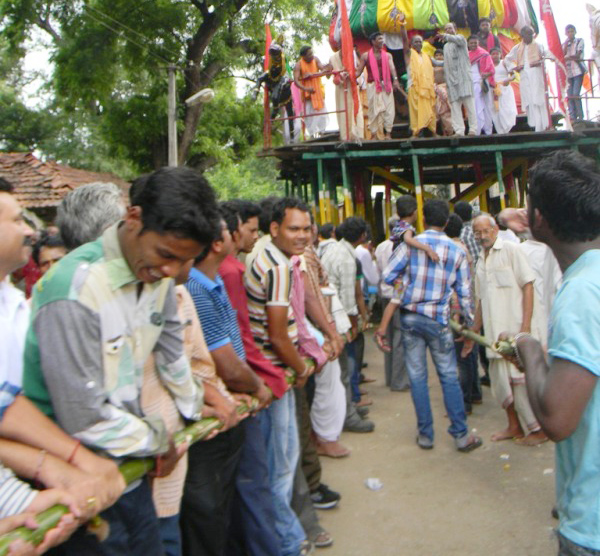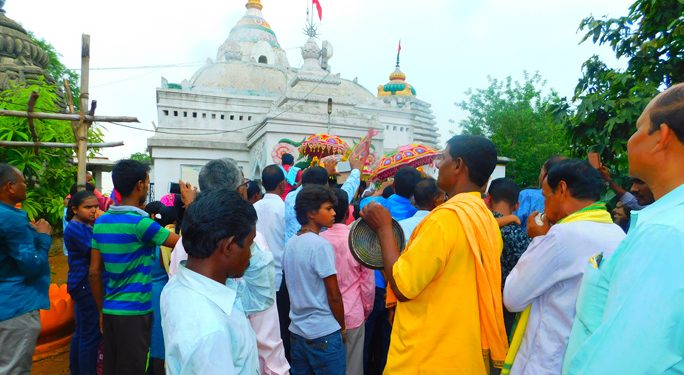Rath Yatra, or Ghosha Yatra, which is the nine-day celebration of the sojourn of Lord Jagannath, Lord Balabhadra and Devi Subhadra, is celebrated for 14 days at the Sri Jagannath temple in Kukurjangha, Jharsuguda district. Here, the festivities to mark the annual outing of the three deities is extended for five days until the full moon when the divine siblings come back to their temple, on the 14th day of Rath Yatra.
“The Sri Jagannath temple at Kukurjangha was built in the 13th century by the erstwhile Kukurjangha zamindars. Once, zamindar Madhusudan Singh had a dream in which he saw three earthen idols of the divine siblings in Beherapalli, a nearby village. So, he went to the village and found the idols there. He built a temple and a ‘mutt mahant’ (priest) was appointed to take care of the temple and the idols. Since then, Rath Yatra is celebrated in this village and the mahants worship the Lords there,” said local zamindar Anil Udhav Kumar Singh, 24, who performs ‘chera pahanra,’ the ritual of sweeping the chariot by the first among the servitors during the Rath Yatra. The 800-year-old tradition is still in vogue at the temple.
As per tradition, the mahant should be a celibate and must be conversant with all rituals. Brahmananda Dasjee Maharaj, the present head of the temple, said, “The previous mahant of the temple died before I came here 15 years ago. I don’t know the exact reason for the unique traditions prevalent here. I tried to find out the reasons from nonagenarians in the village but without success. I approached the Archaeological Survey department in Bhubaneswar along with some villagers to get help for the temple’s maintenance as it had become dilapidated. An ASI team visited the temple and discovered some stones with inscriptions, but they could not be deciphered. They also found some inscriptions on the stone jamb at the entrance relating to the ‘mahants.’ I managed to learn about some rituals of the Rath Yatra at this temple and have followed them.”
There is only one chariot at Kukurjangha which has 16 wheels like the Nandighosh chariot of Puri. The rituals for the Lords are similar to those observed at Sri Mandir. Chariots are pulled after completing all the rituals such as chariot puja, Pahandi, and ‘chera pahanra’, among others.
The three siblings board their chariot and proceed on a sojourn to Gundicha temple, which is just 500 metres away. But, it takes eight days for the chariot to reach its destination. The Trinity stays for a day at the Gundicha temple and returns on the ninth day to the temple at Kukurjangha.
The interesting part of the Yatra is that the 45 ft high chariot is pulled with the help of four bamboos, and not drawn by ropes. As per legend, some villagers once tried to pull the Lord’s chariot with ropes, but it did not move even an inch.
“Pulling a huge chariot with the help of four bamboos is not possible without the spiritual power of the Lord. So, this is a miracle of Lord Jagannath at Kukurjangha,” said Dasjee Maharaj.
On the eleventh day of Rath Yatra, the three siblings at Sri Mandir are attired in ‘Suna Besha’ (golden outfits), but the deities of Kukurjangha are adorned with silver ornaments. The Lords stay on the chariot for three more days before the ‘adhar pana’ ritual and then the Trinity goes back to temple.

Zamindar Anil Kumar Singh said, “I may be the youngest person to perform the ‘chera pahanra’ ritual here. Being the only son, I have to perform the ritual. In 2017, I was studying for graduation outside Odisha when my father fell ill and asked me to come home. He solemnised my thread ceremony and I was made the zamindar to perform certain temple rituals. After him, I had to carry out the rituals for the Rath Yatra here. My father and grandfather had never talked to me about the temple’s history, but they told me that God is always for the devotees so the unique rituals at this place are meant for the convenience of the devotees residing in the nearby villages as well as those from far off places.”
Once Kukurjangha was part of Sambalpur district and pilgrims used to throng the village from neighbouring Chhattisgarh, Bihar and Jharkhand states as well as Sundargarh, Bargarh and Deogarh districts to take part in the unique traditions of the temple.
The reason behind extending the Yatra by five days remains a mystery. However, some villagers point out that village elders who go to participate in the Puri Yatra come back after Bahuda Yatra (return festival), and it is possible that the festivities are extended so that they too can take part in them.
SOYONG, OP






































